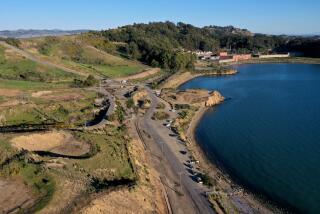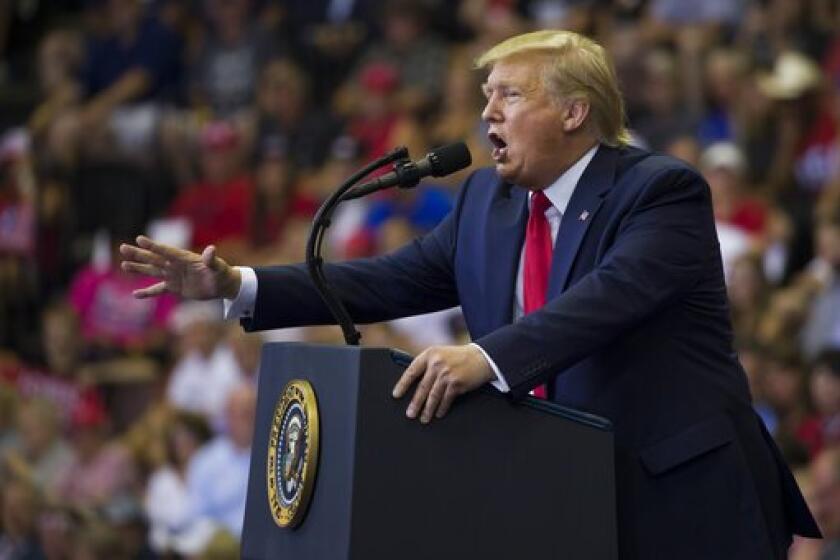Kuehl, Sherman Add Their Voices to the Democratic Chorus
- Share via
It wasn’t prime time. No network news anchors analyzed their remarks. The convention hall did not erupt into thunderous applause. In fact, as they were speaking, the rowdy roomful of delegates continued their schmooze fest on the floor.
But Assemblywoman Sheila Kuehl and congressional candidate Brad Sherman still viewed their appearances before the Democratic National Convention this week as speeches of a lifetime.
Kuehl, who represents portions of the San Fernando Valley and Westside, used her three-minute talk Thursday afternoon to highlight the prevalence of domestic violence and praise President Clinton for addressing it.
“The burning of a black church or a synagogue or wanton violence against my own community, the lesbian and gay community, are calculated acts meant to silence and to terrify,” Kuehl read from her prepared text, which was tweaked here and there by White House speechwriters before going into the convention TelePrompTer. “But nowhere is there a greater crisis of violence than in our homes.”
Kuehl said domestic violence cuts across all classes, races and neighborhoods, a point she said she has learned through years of activism.
Sherman’s talk came the day earlier, joining a parade of Democratic candidates hoping to take back the House and Senate.
After praising Rep. Anthony C. Beilenson (D-Woodland Hills), the retiring lawmaker he hopes to replace, Sherman outlined some of his accomplishments on the State Board of Equalization. He portrayed himself as pro-environment, pro-death penalty, pro-choice. Shifting focus, he said he would strengthen U.S. ties with Armenia and insisted that Turkey “acknowledge the genocide and open humanitarian corridors.”
After stepping down from the stage, both Kuehl and Sherman hoped their speeches would have some lingering effect.
“I really don’t know what impact it will have,” said Kuehl. “Millions and millions of people are watching this convention. C-SPAN is broadcasting the whole thing again and again. My speech won’t make the evening news but there might be one battered woman who hears what I said and thinks, ‘It’s not my fault.’ ”
It was potential voters that Sherman was focusing on.
“The most important message is that I was speaking at all,” Sherman said. “It shows that national Democratic leaders consider this race critical to who controls the House of Representatives.”
Stage Coaches
Before uttering a word, Sherman and Kuehl went through an elaborate pre-speech ritual.
They each arrived at the United Center several hours before their appointed moment at the podium. They headed backstage to a basement hideaway--actually the Chicago Bulls dressing room--where a crack team of White House aides spruced up their speeches, drilled them on how to use a TelePrompTer and told them to relax.
They were assigned a “speaker tracker,” an administration aide whose job it was to make sure they got to the podium on time, not a second too early or late.
Beauticians dabbed them with makeup, straightened their hair--or at least Kuehl’s hair--and adjusted their clothing a bit.
When the time grew near, they waited in a holding area just behind the stage. A producer calmed them down with Zen-like remarks: “Once you walk out there, this hall and the podium are yours.”
Eventually, the convention announcer boomed out their names. The California delegation, seated up front, erupted in applause. And they began.
Ever so slowly, the words they jotted down in their hotel rooms scrolled across the screen and rolled off their tongues. They were ready with a low-tech alternative, however, if the contraption broke down.
Motion with your hand, the producer had said, and a handler will hustle out with the whole thing on paper.
Waiting Games
Besides his appearance at the podium, Sherman had other reasons to smile this week, especially when state Democratic Chairman Art Torres introduced him from the podium at a breakfast attended by the sort of political activists who could help him edge out rival Rich Sybert.
Sherman, however, was hardly alone in being acknowledged by the party leader.
Vice President Al Gore, the featured speaker, was running late, so Torres and Lt. Gov. Gray Davis were doing the best they could to stall.
First, they allowed Willie Brown, the voluble mayor of San Francisco, to go on and on. Then they introduced the members of Congress in the audience. Still, no sign of Gore.
So they introduced state Assembly members, senators and candidates like Sherman. Then it was on to county supervisors and local city council members.
Still, no vice president.
Torres then introduced his son, then Davis’ wife.
Finally, clearly desperate, he quipped: “Is there anyone who would like to be introduced?”
Name Calling
Although the fate of the so-called secession bill by Assemblywoman Paula Boland (R-Granada Hills) is still unclear, some secessionists have taken the time to draft scenarios for a successful San Fernando Valley independence drive.
In the Valley secession Web site, Gerald Silver and Robert Aitchison outline three “what if” scenarios for a breakaway move.
The first is the most obvious: The entire Valley would form its own city, using the Van Nuys Civic Center as its center of government.
Under the second scenario, the Valley would become two cities, divided along the San Diego Freeway into east and west portions. The West Valley’s civic center would be in Canoga Park or Northridge, according to the scenario. The East Valley civic center would be in Van Nuys.
The third option would be the most complicated: breaking the Valley up into three or more cities.
The scenario suggests that “such areas as Canoga Park/Chatsworth or Encino/Tarzana or Sherman Oaks/North Hollywood would form individual municipalities.”
Although the Web site goes so far as to discuss dividing up the ownership of roads, sewers and water service, it does not suggest possible names for the proposed cities.
In the first two scenarios, some commentators and supporters have suggested forming the city of San Fernando Valley or the cities of East and West San Fernando Valley.
In the third scenario, maybe the combination of Canoga Park and Chatsworth could be called Chatsworth Park. Or the combination of Encino and Tarzana could be Enzana or Tarzino.
And maybe combining Sherman Oaks and North Hollywood could create the city of Shermanwood.
Just a suggestion.
Not Easy Being Green
What’s in a name? Quite a lot if you are the Audubon Society.
Audubon chapters from the San Fernando Valley were seeing red last month, when golf course developer David Hueber announced that he would try to revive a controversial golf course project in Big Tujunga Wash.
What set them off is that Hueber’s development company, Foothill Golf, described the project as environmentally sensitive and that it would comply with the “guidelines for the Audubon Signature Cooperative Sanctuary Program.”
The name alone sounds environmentally friendly.
But local Audubon Society chapters oppose the project, saying it would destroy a sensitive habitat, and are miffed that the developer is associating the project with the Audubon Society.
The Audubon Signature Cooperative Sanctuary Program is a certification program for golf courses offered by an organization called the Audubon Society of New York State Inc., which is not affiliated with the National Audubon Society or the New York state chapter of the Audubon Society.
In fact, National Audubon Society President Peter Berle long ago disassociated the group with the certification program.
“They would love there to be confusion,” Audubon spokeswoman Susan Devico said of golf developers who comply with the certification program.
Andrew Baldonado, a spokesman for Foothill Golf, acknowledged that the certification program is not affiliated with the National Audubon Society or any of its chapters.
But he conceded the certification program imposes strict guidelines to protect the environment surrounding a golf course.
“It is an environmentally sensitive and environmentally well-rounded program,” he said.
*
QUOTABLE: “I love L.A. I’d fight for L.A. I’ve been a Dodgers fan all my life, and a Lakers fan.”
--Jason Banks, a Reseda travel agent, on why he opposes secession
Lacey reported from Chicago and Martin from Los Angeles.
More to Read
Get the L.A. Times Politics newsletter
Deeply reported insights into legislation, politics and policy from Sacramento, Washington and beyond. In your inbox twice per week.
You may occasionally receive promotional content from the Los Angeles Times.











